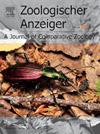揭示西南大西洋浅海和深海腹足纲新分类群和生物地理格局
IF 1.5
3区 生物学
Q2 ZOOLOGY
引用次数: 0
摘要
对乌拉圭和阿根廷海域浅海到深水的边际鱼进行了全面的形态分析,结合了传统技术和几何形态计量学。壳的微观结构,孔洞,原海螺,和penes描述和说明使用扫描电镜图像。证明了几何形态计量学在物种识别中的有效性。在研究区,该科有9个现存种,其中6个为新种,分布于4个属,包括11月臭臭霉,马氏臭臭霉,鲁本臭臭霉,黄臭霉,华氏臭臭霉,castanea臭臭霉,acacularis臭臭霉,abyssalis臭臭霉,cymati臭臭霉,11月臭臭霉,felidamia臭臭霉,11月臭臭霉。至阿根廷的伯德伍德银行(~ 54°S)。其中五种新物种只生活在2457米深的深水中,而其余四种则生活在大陆架上。此外,将两个鲜为人知的南极种Marginella hyalina和Marginella ealesae进行了比较,并将其纳入了Pustinella gen. 11 .中。根据野外观察和博物馆记录,详细介绍了所有物种的地理和水深分布。深海物种显示出受特定洋流影响的聚集模式,而大陆架物种则对应于阿根廷和麦哲伦省。本文章由计算机程序翻译,如有差异,请以英文原文为准。
Revealing new taxa and biogeographic patterns in shallow and deep-sea Marginellidae gastropods of the Southwestern Atlantic
A comprehensive morphological analysis of Marginellidae species from shallow to deep waters off Uruguay and Argentina is presented, incorporating both traditional techniques and geometric morphometrics. Shell microstructure, radulae, protoconch, and penes are described and illustrated using SEM images. The effectiveness of geometric morphometrics in species discrimination is demonstrated. In the study area, the family includes nine living species-six of them new-distributed among four genera, including Pustinella gen. nov. These are Prunum martini, Prunum rubens, Prunum juancarlosi sp. nov., Volvarina warrenii, Volvarina castanea sp. nov., Volvarina acicularis sp. nov., Volvarina abyssalis sp. nov., Pustinella cymatilis gen. et sp. nov., and Pustinella felidamia gen. et sp. nov. These species are restricted to the Southwestern Atlantic, ranging from Rio de Janeiro, Brazil, to Burdwood Bank (∼54°S), Argentina. Five of the new species inhabit exclusively deep waters, down to 2457 m, while the remaining four occur on the continental shelf. Additionally, two poorly known antarctic species, Marginella hyalina and Marginella ealesae are compared and included in Pustinella gen. nov. Lectotype is designed for Marginella fraterculus, a synonym of P. martini, and Marginella dozei is proposed as a new synonym of V. warrenii. Geographic and bathymetric distributions of all species are detailed based on field observations and museum records. Deep-sea species show patterns of aggregation influenced by specific marine currents, whereas shelf species correspond to the Argentine and Magellanic provinces.
求助全文
通过发布文献求助,成功后即可免费获取论文全文。
去求助
来源期刊

Zoologischer Anzeiger
生物-动物学
CiteScore
2.80
自引率
7.10%
发文量
75
审稿时长
>12 weeks
期刊介绍:
Zoologischer Anzeiger - A Journal of Comparative Zoology is devoted to comparative zoology with a special emphasis on morphology, systematics, biogeography, and evolutionary biology targeting all metazoans, both modern and extinct. We also consider taxonomic submissions addressing a broader systematic and/or evolutionary context. The overall aim of the journal is to contribute to our understanding of the organismic world from an evolutionary perspective.
The journal Zoologischer Anzeiger invites suggestions for special issues. Interested parties may contact one of the editors.
 求助内容:
求助内容: 应助结果提醒方式:
应助结果提醒方式:


